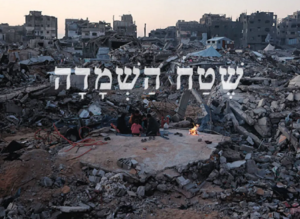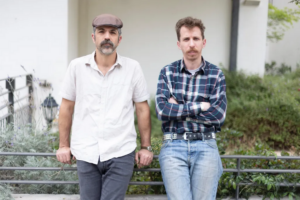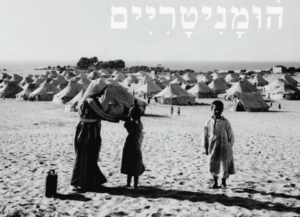‘Depopulation,’ ‘kill zone’, ‘second Nakba’: How Israelis talk about the war in The Lexicon of Brutality

‘Kill zone’. The city of Jabalya in northern Gaza in April 2025
Sheren Falah Saab writes in Haaretz on 4 May 2025:
Fatma Hussein Areib was 11 when she packed up and left her home in Burayr, a village near Gaza that was taken by elite Palmach soldiers during Israel’s War of Independence. “My parents were very scared of the war and said we had to leave,” she recalls of the moments that forever changed her life. “I held my nephew’s hand and we walked a great distance to look for a safe place.”
During this displacement march – Burayr is around 18 kilometers (11 miles) northeast of the Gaza Strip – the family made it to the town of Majdal, where Israel’s resurrected city of Ashkelon is today.
Majdal later fell, and the Areibs spent a few days there. They then arrived in Deir al-Balah in central Gaza, eventually settling in the Shabura refugee camp in Rafah at Gaza’s southern tip. In later years, Fatma married and moved in with her husband in the Jabalya refugee camp in the north, where the couple started a family.
In October 2023, as part of the war that followed Hamas’ attack, northern Gazans were ordered to leave their homes. At 86, Fatma Hussein Areib found herself packing up again, but this time she was in a wheelchair. She and her family relocated to Rafah, where they spent around seven months.
Last May, when the Israeli army invaded the area, the family headed back to Deir al-Balah. “There are similarities between the 1948 Nakba and what has been going on in this war now,” she told Palestinian news agency Wafa after relocating to Rafah. “The thirst, the hunger and the search for a safe place were the main things back then. But this war now is much harder; entire families have been wiped out.”
In a new Hebrew-language book whose title can be translated as “A Lexicon of Brutality,” Adam Raz and Assaf Bondy seek to contribute to the Israeli debate on the war in Gaza and its horrific results.
“The lexicon has come out in book form, but it’s far from complete – not just because more entries need to be included, but because these entries aren’t ‘history’ but a continuous present,” Raz and Bondy write in the introduction. “The entries keep evolving under the shower of shells and missiles, as the pile of bodies in Gaza keeps growing. The rationale behind the policy that produces this is still in power.”

Assaf Bondy, left, and Adam Raz
The book cries out the language prevalent during the war, but its roots reach well before that, of course. As the authors put it, as words lose their moral gravitas, it’s more important than ever to observe how the Israeli discourse shapes the collective consciousness about the Palestinians. This shaping creates a violent reality that ties in directly to the 1948 Nakba, when more than 700,000 Arabs fled or were expelled from their homes during the War of Independence.
According to Raz and Bondy, the use of militaristic, aggressive and violent language not only minimizes the Palestinians’ humanity, it shapes perceptions of reality and public behavior. Analysts, politicians and other people in key positions manipulate words and phrases and in the end control Israelis’ thoughts and behavior.
Part of the war goals
It could be that if Fatma Hussein Areib’s story were reported in the wider Israeli media today, it would be filtered through neutral phrases, hiding the tragedy. We would probably see anchorman Dany Cushmaro interviewing experts like retired general Giora Eiland, who would explain that “there are no uninvolved people in Gaza” and that the only solution is the “Generals’ Plan,” which champions the blocking of food supplies.
Military analyst Nir Dvori would read out “the IDF spokesperson’s comment,” telling how Israeli forces had taken the Philadelphi corridor on the Gaza-Egypt border, so people like Fatma had to evacuate to “humanitarian zones.”
Far-right Finance Minister Bezalel Smotrich would probably stress the need for “depopulation” and “voluntary emigration,” noting that this was part of the “war goals.” To him, as to most studio guests, Fatma and everyone in Gaza are an “existential threat,” so “Gaza should be leveled” by “strategic bombing.”
In “A Lexicon of Brutality,” Raz and Bondy have compiled around 150 phrases including “no uninvolved people in Gaza,” “starvation,” “transfer” and “Nakba 2023” that have peppered the Israeli discourse during the war. We see these phrases in the work of journalists, researchers and human rights activists.
“We wanted to take these commonly used phrases, like the song ‘Harbu Darbu,’ and ask that readers stop for a moment and see what this phrase means, and how by normalizing it we’re becoming a brutal society,” says Bondy, a sociologist.
“We don’t ignore the horrors that Hamas perpetrated against us Israelis. We also don’t ignore the horrors perpetrated by Hamas against Palestinians.
“But we’d like to avoid falling into the symmetry trap that seeks to defuse any deep and genuine criticism. The book cries out the language prevalent during the war, but its roots reach well before that, of course.”
The book opens with the phrase “6:29 A.M.” – when Hamas’ onslaught across the border region began. According to Bondy and Raz, “6:29 A.M. is not the starting point of the tragedy we are living through. People who insist that it is seek to conceal the context, the history of repression – 6:28 A.M. Every action, anywhere and anytime, comes in a context.”

‘Humanitarian zones’. The Gaza Strip in June 1949
According to Raz, a historian and researcher at the Akevot Institute for Israeli-Palestinian Conflict Research, “Understanding the context allows us to understand why we reached a reality where thousands of Palestinians were willing to perpetrate horrors against Israeli civilians and foreign nationals. This context also works in the other direction: why so many Israelis were willing to legitimize the bombing and starving of the civilian Palestinian population, as well as a policy of untrammeled firepower.
“The rationale behind the military’s operations in Gaza and the West Bank wasn’t born on October 7. You can go back to the starting point: 1948. Israel deported hundreds of thousands of Palestinians, destroyed villages, allowed the public to loot the property of their former neighbors, to dry out orchards and fields, and to use great physical violence.”
Phrases like “Second Nakba” and “Nakba 2023” in “A Lexicon of Brutality” convey the Palestinians’ perception of the war, amid images of mass graves in Gaza, mass killing and bodies strewn in the streets. These terms are also used by Israelis.
In November 2023, Agriculture Minister Avi Dichter was asked by Channel 12 whether images of people fleeing northern Gaza could be compared to images of the Nakba. He replied: “We are now in fact unleashing the Gaza Nakba.” When asked again whether this was a “Gaza Nakba,” he said: “The 2023 Gaza Nakba. This is how this will end.”
In 2021, Raz wrote about the 1948 Deir Yassin massacre in Haaretz, where, using testimonies and documents, he put together a chilling picture of killings by Israeli soldiers during the War of Independence. The unveiling of minutes from cabinet meetings in 1948 reinforced the realization that the government was aware of what was happening and that the Deir Yassin massacre wasn’t unusual.
Today, phrases in “A Lexicon” such as “depopulation,” “rubble,” “voluntary emigration” and “Amalekites” – mentioned in the general Israeli debate and by politicians alike – give Palestinians a feeling of déjà vu. Prime Minister Benjamin Netanyahu even said on October 29, 2023: “This is our second War of Independence …. This is our life’s task; it’s also my life’s task.”
As Raz puts it, “Minutes from cabinet meetings in 1948, released after decades and still not in full, show that alongside decision-makers’ awareness of events on the ground such as expulsions and acts of massacre and looting, some also expressed shock. It’s obvious that many cabinet members realized that their deeds would shape the society taking shape.
“The current government stands out . … That is, there is an explicit policy of transfer, murder and starvation, and this is leading more and more people in Israel and around the world to blame Israel for perpetrating the crime of crimes: genocide.”
Raz adds: “In Deir Yassin and Kafr Qasem the killing was done at close range. Today, a pilot, maybe a [left-wing] Meretz voter, drops a one-ton bomb on a humanitarian zone, sometimes without knowing what he’s bombing. The next day he opens Haaretz, reads a story and gets angry. He’s not willing for his country to act with such brutality. There’s no doubt that the conditions of the fighting have changed.”
According to Bondy, notable about the current war “is the brutal use of words. There’s no longer any shame or desire to conceal. That’s what’s so unique about this war. From the first moment, the leaders have been saying exactly what they’re going to do – and they do exactly that.
“This is so shocking that we decided that, rather than focus on the actual deeds or a legal analysis of the deeds, we would focus on the language that lays bare so much of the deeds but mainly the reality we live in.”
Some of the phrases in the book refer directly to Israeli society such as “Israeli flag.” “Already during the judicial overhaul in the months before the war, the center and left appropriated the national flag after it had been a staple of right-wing displays such as the Flag March in East Jerusalem,” Raz and Bondy write.
“The waving of flags at protests reflected a war over ‘the home,’ over the country, over the essence of the regime.” But the two authors add that “the flag also expresses the exclusion of Israeli Palestinians from the protest against the war, as well as for a hostage deal.
“Waving the flag does reflect an honest desire to topple the current bloody government, but it also sometimes indicates an acceptance of the reality of recent decades: occupation, Jewish supremacy, settler violence and the theft of Palestinian property. This was evident when many people were moved when they saw our brave soldiers raising the flag in Gaza in November 2023 (and many times since).”
Nothing new
The deeper you delve into the phrases in “A Lexicon of Brutality,” the more you realize that the contemporary linguistic strategy reflects a perception of Palestinians that began in 1948 and is still going strong.
For example, “humanitarian zones” replaces the “security zones” seen in previously censored documents in the state archives. That phrase substitutes for the transfer of Palestinians after their cities were taken in 1948.
According to Jaffa resident Ismail Abu Shehade in one document, “They surrounded us with barbed wire and three gates; we could only leave the zone to work in one of the citrus orchards around town, which required confirmation from our employer.”
Today, however, no free movement is allowed in Gaza, and a Palestinian moving around is taking a risk, as told by Aisha, a former Gaza City resident who relocated to the Muwasi area in southwest Gaza, which was declared a humanitarian zone.
“We’re afraid to go back to the city because we’re scared we’ll run into the army and be shot at,” she told Haaretz. “The sense is being stranded and under threat of death because humanitarian zones sometimes get bombed, too.”
In 1948, the phrase “voluntary emigration” was employed to cushion a policy of displacement in moderate, emotionless words. According to minutes from cabinet meetings, Minority Affairs Minister Bechor-Shalom Sheetrit addressed the displacement of Palestinians in the central city of Lod.
“According to military estimates, 3,000 residents remain. Forty-eight hours after the conquest, no residents remain in either Lod or Ramle. I wasn’t aware of, nor could I get a response, on whether those residents have been displaced by force or voluntarily.
“If they left voluntarily, that’s their own business. If they have been displaced by force, this must be sorted out. “The [Arab] population around the country, mainly in the cities, has greatly decreased. In the villages where some residents remain, a constant war [of words] is going on with the army on whether to leave them alone or displace them. My demand is to set a clear line of action that will prevent the lawlessness that has taken root on our side.”
The term “looting,” also in “A Lexicon,” isn’t new either. This phenomenon happened in 1948, as described by Raz in his Hebrew-language book “Looting of Arab Property in the War of Independence.” “In the lexicon we show that commanders allowed soldiers to loot. This is a combination of greed and revenge against Palestinians,” he says.
“What’s so surprising here is that in 1948 this was nothing to boast about. No opinion pieces came out in favor. But today, there are videos of soldiers looting that are almost pornographic. That is, they see it as something positive. They expect to earn cultural capital from their looting.”
Some of the phrases are context-dependent. For example, the phrase “The IDF still has a lot of work to do” recalls Smotrich’s remarks in 2021 when he addressed Arab lawmakers from the Knesset podium. “You are here by mistake,” he said. “Ben-Gurion didn’t get the job done and didn’t throw you out in 1948.”
Raz: ‘Today, there are videos of soldiers looting that are almost pornographic. That is, they see it as something positive.’ Raz sees this as one link in a long chain. “Nothing is new here. When they talk about ‘starvation,’ Israel didn’t begin depriving Palestinians of food just now. It has been counting calories for them for years, on both sides of the Green Line.”
He backs his claims with documents from the early ’50s, when Bedouin in the Negev were concentrated in a certain area after the War of Independence. “This was done to take over fertile land and, in part, to control Palestinians’ nutrition,” Raz says. “You can’t understand the current policy of starvation if you believe that it came out of nowhere. Israel has been blockading Gaza for many years.”
He says that practices currently in use in Gaza such as “house burnings” and “kill zones” (phrases in “A Lexicon” ) are nothing new. The only difference is “in intensity, not the rationale. Israel has been controlling the movement of Palestinians and taking over their land since 1948.”
Despite the brutal language and harsh reality, Bondy is still looking forward to the future. “We have hope that Israeli society has not yet leaped into the abyss, hope that at least some people who read this book will attend protests and hold up another sign next to the sign calling for the release of the hostages,” he says.
Bondy hopes that “more people will call – around the dinner table, in living rooms and at protests – for an end to this terrible war; that some of our readers will do something for more coexistence in the region.”
This article is reproduced in its entirety
